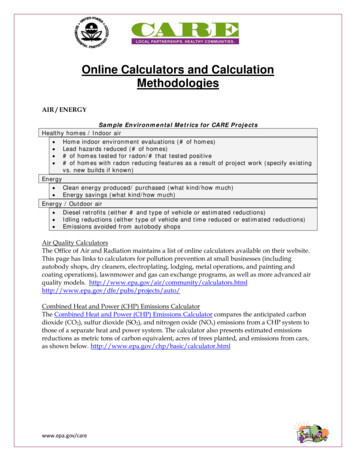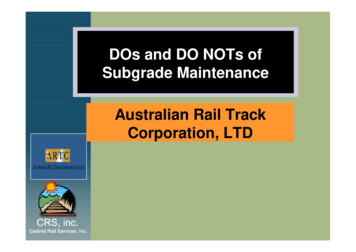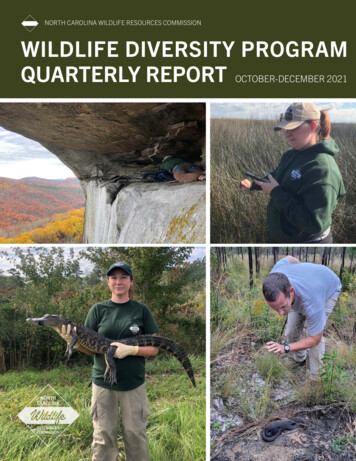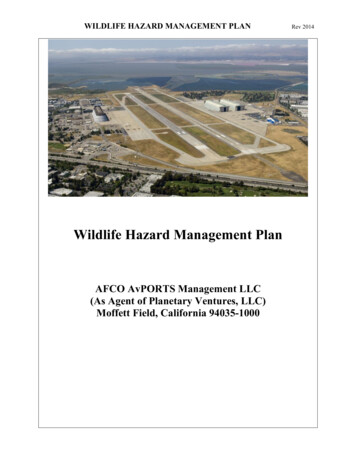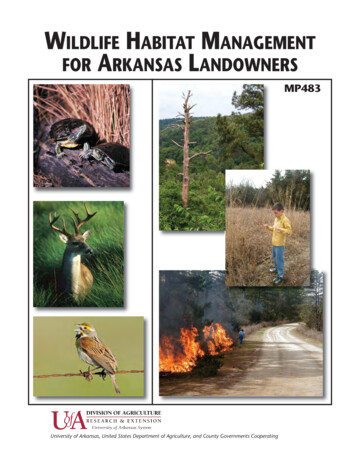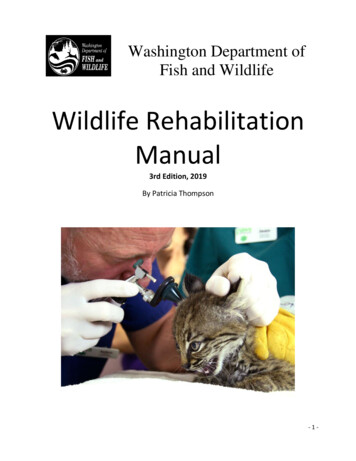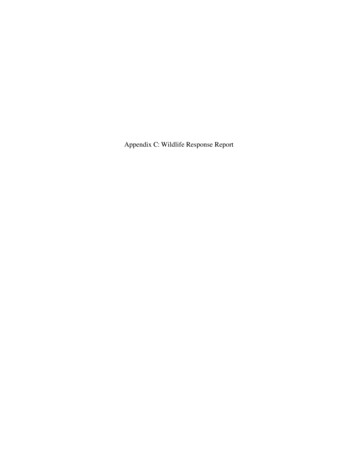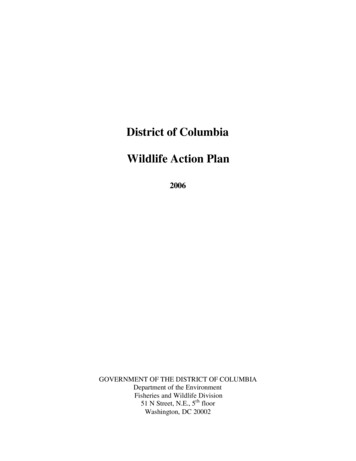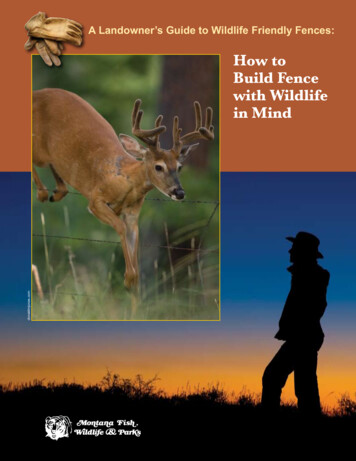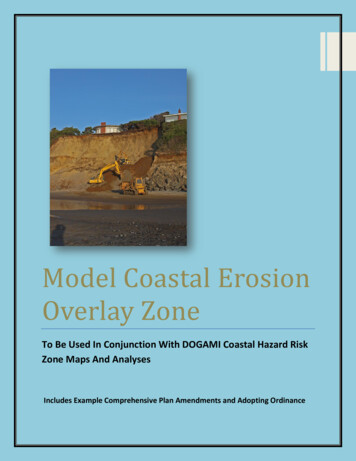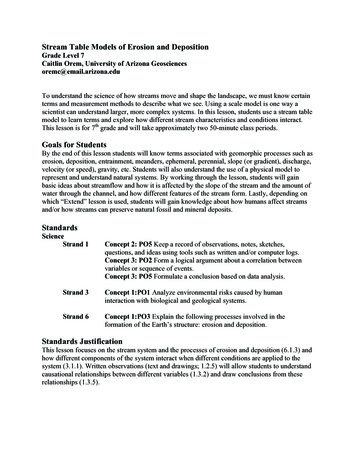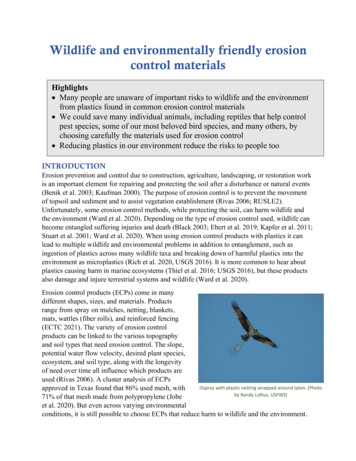
Transcription
Wildlife and environmentally friendly erosioncontrol materialsHighlights Many people are unaware of important risks to wildlife and the environmentfrom plastics found in common erosion control materials We could save many individual animals, including reptiles that help controlpest species, some of our most beloved bird species, and many others, bychoosing carefully the materials used for erosion control Reducing plastics in our environment reduce the risks to people tooINTRODUCTIONErosion prevention and control due to construction, agriculture, landscaping, or restoration workis an important element for repairing and protecting the soil after a disturbance or natural events(Benik et al. 2003; Kaufman 2000). The purpose of erosion control is to prevent the movementof topsoil and sediment and to assist vegetation establishment (Rivas 2006; RUSLE2).Unfortunately, some erosion control methods, while protecting the soil, can harm wildlife andthe environment (Ward et al. 2020). Depending on the type of erosion control used, wildlife canbecome entangled suffering injuries and death (Black 2003; Ebert et al. 2019; Kapfer et al. 2011;Stuart et al. 2001; Ward et al. 2020). When using erosion control products with plastics it canlead to multiple wildlife and environmental problems in addition to entanglement, such asingestion of plastics across many wildlife taxa and breaking down of harmful plastics into theenvironment as microplastics (Rich et al. 2020, USGS 2016). It is more common to hear aboutplastics causing harm in marine ecosystems (Thiel et al. 2016; USGS 2016), but these productsalso damage and injure terrestrial systems and wildlife (Ward et al. 2020).Erosion control products (ECPs) come in manydifferent shapes, sizes, and materials. Productsrange from spray on mulches, netting, blankets,mats, wattles (fiber rolls), and reinforced fencing(ECTC 2021). The variety of erosion controlproducts can be linked to the various topographyand soil types that need erosion control. The slope,potential water flow velocity, desired plant species,ecosystem, and soil type, along with the longevityof need over time all influence which products areused (Rivas 2006). A cluster analysis of ECPsOsprey with plastic netting wrapped around talon. (Photoapproved in Texas found that 86% used mesh, withby Randy Loftus, USFWS)71% of that mesh made from polypropylene (Jobeet al. 2020). But even across varying environmentalconditions, it is still possible to choose ECPs that reduce harm to wildlife and the environment.
WILDLIFE ENTANGLEMENTErosion control products that contain plastic mesh or netting pose the largest threat for wildlifeand the environment (Barton & Kinkead 2005; Black 2003; Ebert et al. 2019; Kapfer et al. 2011;Stuart et al. 2001; Townsend & Barker 2014; Walley et al. 2005; Ward et al. 2020). Wildlifeentanglement, causing injury and death, occurs when animals get caught in plastic netting foundin erosion control mats and blankets. Negative impacts from plastic netting reach across allspecies groups, including snakes, frogs, lizards, turtles, fish, small mammals, and birds (Stuart etal. 2001).Reptiles and amphibians may be most as-risk from plastic-containing erosion control products.Reptiles and amphibians use the environment toregulate their body temperature; when theybecome entangled in plastic netting it puts themin danger of becoming exposed to temperaturesextremes that they would normally not chooseto remain in, leading to stress and sometimesdeath (Herpetological Resources andManagement 2019). Snakes become entangledin the plastic netting leading to injury and death(Mitchell et al. 2006). Reports of fatalitiesinclude the eastern massasauga rattlesnake(Sistrurus catenatus), a federally threatenedspecies. Eastern massasaugas live in wet areas,such as marshlands, prairies, areas aroundEastern massasauga rattlesnake found dead in plastic netting.lakes/rivers and other habitat-transition zonesUSFWS photo.(MNFI n.d.; USFWS 2019).Not all species are affected equally, with larger-sized snakes, including gravid females, morevulnerable to entanglement. For snakes between 50-199 mm circumference, every increase inmm of circumference lead to an increase of predicted entanglement (Ebert et al. 2019).Entanglement can cause lacerations in the skin, open wounds can lead to infection, decreasedmobility, and eventually death even if they manage to break free from the netting (D. Mifsud,pers. comm., 2020). Reported species of snakes and lizards that have been observed tangled inplastic netting include: eastern fox snake (Pantherophis gloydi), gray rat snake (Pantherophisspiloides), Butler’s garter snake(Thamnophis butleri), easternmassasauga rattlesnake (Sistruruscatenatus), northern watersnake(Nerodia Sipedon), black ratsnake(Elphae obsoleta), timber rattlesnake(Crotalus horridus), coachwhips(Masticophis flagellum), bullsnakesEastern king snake killed in plastic erosion control netting.(Pituophis catenifer), westernPhoto by Meredith Semel
diamondback rattlesnakes (Crotalous atrox), racers (Coluber constrictor), ratsnakes (Elapheobsolete), kingsnakes (Lampropeltis getula), spiny lizards (Sceloporus magister) (D. Mifsud,Herpetological Resources Management, pers. comm. 2020; Fauth & Welter 1994; Stuart et al.2001).Snakes are not the only wildlife that are harmed by erosion control products (Stuart et al. 2001).Research shows that birds will use discarded plastic netting as filler in their nests. Birds can havedecreased nest success and plastic netting can lower fledgling success due to entanglement andindigestion of plastics (Montevecchi 1991; Townsend et al. 2014). Rich et al. (2020) gathereddata from multiple sources showing that birds, turtles, snakes, and invertebrates have all beendocumented becoming entangled, ingested, or killed by plastic netting products in theenvironment. Bird species that weretangled or ingested plastic weremourning dove (Zenaida macroura),European coot (Fulica atra), mallard(Anas platyrhynchos), shelduck(Tadorna tadorna), osprey (Pandionhaliaetus), American black duck (Anasrubripes), common eider (Somateriamollissima), American crow (Corvusbrachyrhynchos), American robin(Turdus migratorius), Eastern bluebird(Sialia sialis), California condorPlastic netting found in bird nest. Photo by Peter McGowan, USFWS.(Gymnogyps californianus), and greattit (Parus major) (Rich et al. 2020).POLLUTION & MICROPLASTICS IN THE ENVIRONMENTECPs are just one of the many sources for plastic pollution, but the plastic contained in someerosion control products does contribute to the problem. Plastic netting in erosion controlproducts can lead to long term pollution and contribute to microplastics and chemicalcontaminants in our soils and water. Fragments of plastic can break off from the netting and leadto microplastics in water and chemicals leached from the plastics into water and soil that remainin place following the restoration of the site (USGS 2016). Research has shown thatpolypropylene, commonly used in plastic erosion netting, can lead to long-term environmentalproblems (Kärrman et al. 2016). Chemical additives from plastics leach into the environment,including chemicals that stabilize plastics from UV exposure like those used in some ECPs; thesechemicals may cause immediate and long-term harm to mammals, amphibians, fish, andinvertebrates (Rich et al. 2020). Soil chemistry and physical properties can also be altered fromplastics used in the environment (Rich et al. 2020). Fragments of plastic that end up in lakes,streams, and rivers can also end up ingested by fish and other wildlife. A recent study showedthat polypropylene was the most prevalent microplastic in freshwater mussels, 71% of which hadmicroplastics when tested (Wardlaw & Prosser 2020).
Even products that claim to be biodegradable may not degrade over time. Many of the so-calledbiodegradable plastics need the sunlight to assist in the degradation process but once vegetationgrows up between the netting, it is shaded and will remain in the environment indefinitely unableto degrade as promised (USGS 2016).WILDLIFE FRIENDLY PRODUCTSThe good news is that there are alternative erosion control products to choose from that are morewildlife and environmentally friendly. First, choose a product that does not contain plasticnetting for ECPs such as blankets, mats, and logs. There are products made from natural fibersthat can replace plastic netting (examples in Fig 2-5) in these products. To reduce entanglement,the joints in netting need to be moveable and un-welded to allow wildlife to escape. The size ofthe opening in the mesh can also make a difference. Instead of choosing square mesh, useelongated mesh with a rectangular shape (Ebert et al. 2019; Herpetological Resource andManagement, 2019; Kapfer et al. 2011). This allows a snake or other animal to wiggle out moreeasily while avoiding injury in the process. Natural fibers also have varying shelf lives and willbreak down, not polluting or leaching chemicals and microplastics into the environment. Whenlooking for erosion and sediment control methods, consider options when marketed as“degradable” versus “biodegradable” products. Most erosion and sediment control products aredesigned to degrade over time and are considered temporary, whether due to natural processes ofdegradation or by removal. One marketing strategy is to push for UV-degradable products,which often do not work as intended, due to vegetation cover of the mesh. Many of theseproducts will end up being left in place for long periods of time. Plastic netting products havebeen found intact up to eight years after its initial installation (USDA and NRCS 2013). This isespecially true when they are being used for vegetation reestablishment purposes or waterretention, for there is fear of damaging growth upon its removal. The concern with degradableplastics is that many petroleum-based products eventually do degrade but because of the time tobreak down, they end up breaking into small pieces which result in microplastics in lakes, riversand other waterways. Fragments of netting can result in entanglement of wildlife, ingestionhazards, or increases in the concentration of pollutants found in the environment.Silt fences are another temporary erosion control product that are often used. These preventsediment from moving with storm water runoff. They are made of plastic filters and are may bereinforced with more plastic netting or metal mesh. Backing is used in the case of heavysediment load. The mesh netting on some of these products has smaller apertures and have beendocumented to entrap and harm snakes, including the Eastern massasauga (Black 2003). Nonreinforced silt fences tend to be a more wildlife friendly choice, however, as the fence is left up,it begins to wear, fray, and develop holes, which may also contribute to wildlife entanglement.Alternatives exist that are made from heavy-duty polymer matrices from recycled materials thatdo not break down and can be reused on multiple projects. These products can be installed withone-way wildlife openings letting wildlife escape from construction zones, while keeping themout and controlling erosion and runoff (ERTEC).
Consult with an engineer as sometimes it is possible to design a site to reduce the slope so that amore environmentally erosion control method can be used. For example, terraces added to someslopes, can reduce the sediment yield because there is less overall erosion occurring on less steepterraced slopes. Engineers may also be able to design a mock terrace by using sediment logs(Fig. 9) interlaced to slow the flow combined with plastic free erosion control blankets. Whereappropriate, ridges, channels, and impoundments should also be used where applicable to slowand control erosion (RUSLE2).If you must use plastic due to the slope, water flow velocity, or other factors on your site, thereare still options that are less risky to wildlife. Plastic netting that is larger and rectangular inshape (Fig. 4) reduces wildlife entanglement compared to products that contain square-shapedmesh (Fig. 6-7). Choosing moveable, unwelded joints (sometimes called “leno weave”) allowswildlife to get out of netting even if it is plastic based. Keeping ECPs secure and installing themcorrectly helps reduce the risk to wildlife. Ward et al. (2020) found that burying the edges oferosion control blankets reduced the number of snake entanglements in the erosion controlnetting. Another means to secure ECPs is using wooden or 'live' stakes; these can keep ECPs inplace, reduce the ability for wildlife to crawl underneath, and help aid in vegetation growth whennative live stakes are used (Rivas 2006). For more information the Forest Service has a detailedguide titled “Erosion Control Treatment Selection Guide” by Rivas (2006).Many state agencies, municipalities, and manufacturers of erosion control products are aware ofthe dangers that some designs of ECPs pose to wildlife and the environment and are takingaction to reduce its use in their geographic areas. California, Illinois, Minnesota, Vermont, andWisconsin have created guidelines for the use of environmentally friendly ECPs (CaliforniaCoastal Commission 2012; Illinois Department of Natural Resources 2020; MN Department ofNatural Resources 2013; Slesar, C. 2009; Wisconsin Department of Natural Resources). TheNRCS has a fact sheet the use of snake-friendly erosion control materials in Indiana, and they areupdating their standards in Illinois to reflect the need to protect wildlife from plastics in ECPs(Brad Semel, Illinois Department of Natural Resources, pers. comm., 2021). To have a greaterimpact, collaboration is needed across all levels of government and non-government groupsincluding but not limited to manufacturers, contractors, farmers, and the public.In summary, based on our review of the scientific literature on the effects of ECPs on wildlifeand the environment, we recommend choosing products with natural fiber netting, or no netting(such as spray on mulch); products with 100% biodegradable materials; carefully installingmaterials using natural stakes and burying edges; and removing ECPs when no longer needed.
Figure 1. Attributes of erosion control products that make them not friendly to wildlife, somewhat more friendly, and friendly towildlife. Use the specifications in the wildlife friendly box as much as possible.ConclusionDepending on the erosion control product that you use, the negative byproduct of your erosioncontrol can be minimized by using wildlife-friendly products that will reduce entanglement ofwildlife and reduce environmental pollution associated with plastic netting. By using certainproducts over others and reducing the risks to wildlife you are taking a proactive approach andcontributing towards the stewardship and conservation of all species. For more information,please see https://fws.gov/midwest/eastlansing/ecp.html for more information the products wereviewed and whether they meet the definition of wildlife friendly according to the criteria foundin published literature. We hope that this will assist you to find the best product for your projectthat suite your erosion control needs and reduces risk to wildlife.
Citations1. Barton, C., & Kinkead, K. (2005). Do erosion control and snakes mesh? Journal of Soiland Water Conservation, 60(2), 33A.2. Benik, S.R., B.N. Wilson, D.D. Biesboer, B. Hansen, and D. Stenlund. 2003. Evaluationof erosion control products using natural rainfall events. Journal of Soil and WaterConservation 58(2):98-105.3. Black, R. (2003). Conservation Advisory: Heavy duty silt fence may cause high mortalityin large-bodied snake species. Ministry Natural Resources. Ontario, Canada.http://www.massasauga.ca/pub docs/Advisory silt fence.pdf4. California Coastal Commission. (2012). Water Quality Fact Sheet: Wildlife-FriendlyPlastic-Free Netting in Erosion and Sediment Control endly Products.pdf.5. Ebert, S. E., Jobe, K. L., Schalk, C. M., Saenz, D., Adams, C. K., & Comer, C. E. (2019).Correlates of snake entanglement in erosion control blankets. Wildlife Society Bulletin,43(2), 231-237. https://doi.org/10.1002/wsb.9636. Environmental Conservation Online System, USFWS.https://ecos.fws.gov/ecp/species/8193 Date Accessed: 7/21/21.7. ECTC: Erosion Control Technology Council. https://www.ectc.org/ Date Accessed:6/10/2021.8. ERETC: Environmental Systems. /ERTEC-E-Fence-Brochure.pdf Date Accessed: 7/26/2021.9. Fauth, J. E., & Welter, S. M. (1994). Nerodia sipedon (Northern Water Snake): Fatality.Herpetological Review, 25, 29.10. Herpetological Resource and Management, LLC. 2019. Evaluation of Soil ErosionControl Netting and Impacts on Herpetofauna.11. Illinois Department of Natural Resources. 2020. Plastic Erosion Control Blankets andWildlife Don’t Mesh.12. Kapfer, J. M., & Paloski, R. A. (2011). On the threat to snakes of mesh deployed forerosion control and wildlife exclusion. Herpetological Conservation and Biology, 6(1), 19.13. Kaufman, M.M. 2000. Erosion control at construction sites: The science–policy gap.Environmental Management 26:89-97.14. Kärrman, A., Schönlau, C., & Engwall, M. (2016). Exposure and effects of microplasticson wildlife: A review of existing data.15. Jobe, K., Schiwitz, N. C, Ward, K., Saenz, D., & Schalk, C. M. (2020). On the Diversityof Erosion Control Products: Implications for Snake 20/Posters/11/ Date Accessed: 6/15/2021.16. Michigan natural features inventory. (n.d.). Michigan Natural Features tion/11519/Sistrurus-catenatus17. Mitchell, J. C., Gibson, J. D., Yeatts, D, & Yeatts, C. R. 2006. Observations on SnakeEntanglement and Mortality in Plastic and Horticultural Netting. Bulletin of the VirginiaHerpetological Society, 26(2): 64-69.
18. MN Department of Natural Resources. (2013). Wildlife Friendly Erosion wildlife-friendly-erosion-control.pdf19. Montevecchi, W. A. (1991). Incidence and types of plastic in gannets' nests in thenorthwest Atlantic. Canadian Journal of Zoology, 69(2), 295-297.20. Rich, L. N., Mantor, M., Ferguson, E., Baker, A. D., & Chappell, E. (2020). Potentialimpacts of plastic from cannabis cultivation on fish and wildlife resources.CALIFORNIA FISH AND GAME, 106, 121-132.21. Rivas, Todd. 2006. Erosion Control Treatment Selection Guide. USDA Forest Service.https://www.fs.fed.us/t-d/pubs/pdf/hi res/06771203hi.pdf Date accessed: 6/15/202122. RUSLE2 - https://fargo.nserl.purdue.edu/rusle2 dataweb/RUSLE2 Index.htm. DateAccessed: 6/15/202123. Slesar, C. 2009. Wildlife-Friendly Erosion Control Matting: The Standard for Vermont.Vermont Agency of Transportation.24. Stuart, J. N., Watson, M. L., Brown, T. L., & Eustice, C. (2001). Plastic netting: Anentanglement hazard to snakes and other wildlife. Herpetological Review, 32(3), 162164.25. Thiel, M., Luna-Jorquera, G., Álvarez-Varas, R., Gallardo, C., Hinojosa, I. A., Luna, N.,Miranda-Urbina, D., Morales, N., Ory, N., Pacheco, A.S. and Portflitt-Toro, M., &Zavalaga, C. (2018). Impacts of marine plastic pollution from continental coasts tosubtropical gyres—fish, seabirds, and other vertebrates in the SE Pacific. Frontiers inMarine Science, 5, 238.26. Townsend, A. K., & Barker, C. M. (2014). Plastic and the nest entanglement of urban andagricultural crows. PLoS One, 9(1), e88006.27. U.S. Fish and Wildlife Service. (2019, May 29). USFWS: Eastern massasauga fact les/eama/eama-fct-sht.html28. Walley, H. D., King, R. B., Ray, J. M., & Robinson, J. (2005). Erosion mesh netting amajor threat hazard to snakes. Bulletin of the Maryland Herpetological Society, 41(1),36-38.29. Ward, K. J., Jobe, K. L., Schiwitz, N. C., Saenz, D., & Schalk, C. M. (2020). Risk ofsnake entanglement is affected by installation method of erosion control blankets. Journalof Fish and Wildlife Management, 11(1), 273-278.30. Ward, K. J., Jobe, K. L., Schiwitz, N. C., Saenz, D., & Schalk, C. M. (2020). Thediversity of erosion control products and implications for wildlife entanglement. Journalof Soil and Water Conservation, 75(4), 82A-87A.31. Wardlaw, C., & Prosser, R. S. (2020). Investigation of Microplastics in FreshwaterMussels (Lasmigona costata) From the Grand River Watershed in Ontario, Canada.Water, Air, & Soil Pollution, 231(8), 1-14.32. Wisconsin Department of Natural Resources. Technical Standard:Channel Erosion Mat(1053). ChannelErosionMat.pdf DateAccessed: 6/20/202133. USDA and NRCS. (2013). Biology Fact Sheet: Guidelines for Use of Snake-FriendlyErosion Control Blankets.
N/Fact Sheet Biology SnakeFriendly Netting.pdf. Date Accessed: 6/15/202134. U.S. Geological Survey. Microplastics in our Nation’s Waterways. s/microplastics/index.html. Date Accessed:6/15/2021
Appendix 1. Photos and measurements of different types of erosion control mats.Figure 2 Curlex NetFree. Aspen excelsior contains no netting. Slopes 3H:1V, Channels 1.0 lb/ft2 (48 Pa) shear stress, 3.0 ft/s(0.9 m/s) velocity. True biodegradable, seed free. Wildlife friendly.
Figure 3 Curlex I. Aspen excelsior contains FibreNet netting on one side (1in * 0.5 in) jute with moveable joints. Slopes 2H:1V,Channels 1.75 lb/ft2 (84 Pa) shear stress, 7.0 ft/s (2.1 m/s) velocity. True biodegradable, seed free. Mowable 90 days. Wildlifefriendly.
Figure 4 Curlex II. Aspen excelsior contains FibreNet netting on two sides (1in * 0.5 in) jute with moveable joints. Slopes 1.5H:1V, Channels 2.25 lb/ft2 (108 Pa) shear stress, 9.0 ft/s (2.7 m/s) velocity. True biodegradable, seed free. Mowable in 90days. Wildlife friendly.
Figure 5 Curlex III. Aspen excelsior contains FibreNet netting on two sides (1in * 0.5 in) jute with moveable joints. Slopes 1H:1V,Channels 2.5 lb/ft2 (120 Pa) shear stress, 10.0 ft/s (3.1 m/s) velocity. True biodegradable, seed free. Mowable in 90 days.Wildlife friendly.
Figure 6 Curlex I. Aspen excelsior contains standard polypropylene netting on one side (2 in * 1 in) welded joints, oxobiodegrader, and UV additives. Slopes 2H:1V, Channels 1.75 lb/ft2 (84 Pa) shear stress, 7.0 ft/s (2.1 m/s) velocity. Seed free.Larger mesh size makes this less risky to snakes, but does not meet criteria for fully wildlife friendly.
Figure 7 Trinet Curlex side 1. Aspen excelsior contains standard polypropylene netting on both sides (0.5 in * 0.5 in) weldedjoints, heavy duty, and UV stabilized. Slopes 5H:1V, Channels 13 lb/ft2 (622 Pa) shear stress, 20.0 ft/s (6.1 m/s) velocity. Seedfree Permanent reinforcement, also available in natural straw/coconut, natural coconut, Recyclex synthetic fibers with the samenetting. Not wildlife friendly.
Figure 8 Trinet Curlex side 2. Aspen excelsior contains standard polypropylene netting on both sides (0.5 in * 0.5 in) weldedjoints, heavy duty, and UV stabilized. Slopes 5H:1V, Channels 13 lb/ft2 (622 Pa) shear stress, 20.0 ft/s (6.1 m/s) velocity. Seedfree Permanent reinforcement, also available in natural straw/coconut, natural coconut, Recyclex synthetic fibers with the samenetting. Not wildlife friendly.
Figure 9 Curlex sediment log. Aspen excelsior covered in open weave containment fabric on both sides (0.5 in hexagon) openweave joints. Filters and reduces hydraulic energy and sediment runoff. Available in 20, 12, 9, 6 inch or customizable lengths.Seed free, 24 months lifespan. Open weave mesh makes this less risky to wildlife.
One marketing strategy is to push for UV-degradable products, . are still options that are less risky to wildlife. Plastic netting that is larger and rectangular in shape (Fig. 4) reduces wildlife entanglement compared to products that contain square-shaped . guide titled "Erosion Control Treatment Selection Guide" by Rivas (2006).
